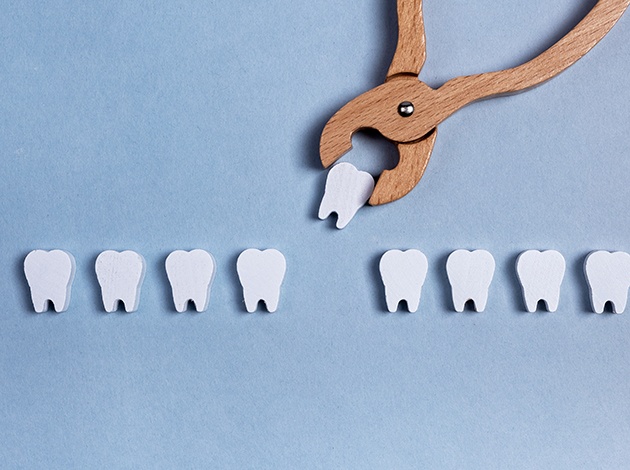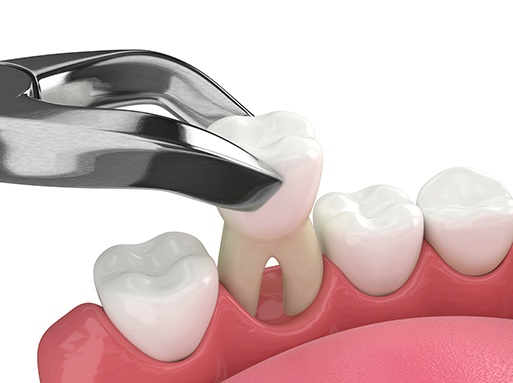Kids Tooth Extractions—Dublin, CA
How We Make Troublesome Teeth Disappear
Even though their baby teeth are supposed to fall out on their own, many children end up needing a tooth extraction in Dublin for the sake of their oral health and daily comfort. While the team at Waterford Pediatric Dentistry & Orthodontics of Dublin does everything we can to help our growing patients preserve their natural teeth for as long as possible, issues like decay, accidents, and stubborn baby teeth may require us to help nature along. If you think your child has a problem tooth that needs to go, call us today to schedule their appointment.
Why Choose Waterford Pediatric Dentistry & Orthodontics of Dublin for Kids Tooth Extractions?
- Led by Multiple Certified Pediatric Dentists
- Same-Day Emergency Dental Appointments
- Sedation Dentistry for Anxious Kids
Reasons Why Tooth Extractions Are Necessary

Your child’s dentist might recommend a tooth extraction if…
- The tooth is so damaged or decayed that it can’t be repaired with a filling or crown
- A persistent baby tooth won’t fall out and is blocking an adult tooth
- More room is needed in the mouth for orthodontics
The Process of Removing a Tooth

The first thing we tell every child and parent before an extraction is that we never pull teeth. Rather, we gently wiggle one until it slips out on its own! We understand that this kind of procedure can make people nervous, so we’ll be sure to answer you and your child’s questions to put your minds at ease.
On the day of treatment, we’ll thoroughly numb the area, provide sedation if needed, and do everything we can to ensure your child stays calm and comfortable throughout the entire process.
Tooth Extraction Aftercare

You should plan on your child staying home from school or daycare on the day of their extraction. We’ll have them bite down on a small piece of gauze to help control the bleeding (this is normal), and it will need to be changed out after a few hours.
Do your best to make sure your child doesn’t use their tongue or fingers to mess with the treatment site. It needs time to heal like any other “boo boo!” They should ideally avoid drinking with a straw, spitting, or engaging in any rigorous physical activity for the rest of the day.
Stock up on items like yogurt, soup, pudding, and scrambled eggs so they can follow a soft food diet for at least the first few days. This will give their mouth the best possible chance to heal nice and fast.
Understanding the Cost of Tooth Extractions

Now that you know more about why your child might need to have a tooth extracted and how the process works, it’s natural to wonder how much it costs. You might not pay the same exact amount as someone else because it depends on your unique circumstances. Once your family has consulted with one of our providers, our team can share a detailed estimate for your approval before we proceed.
Keep reading below to learn more about how the final amount is determined, and feel free to contact us with any additional questions.
Factors That Can Affect Tooth Extraction Cost

Once we’ve had the chance to examine your problematic tooth, we’ll have a better idea of what it will take to successfully remove it. Some factors that can influence the price of your extraction can include:
- How many teeth are affected. Patients having multiple teeth removed can expect to pay more than someone who only needs a single extraction.
- Where the tooth is located. Molars in the back of your mouth are harder to access and might require additional time and work, which can increase the rate.
- The severity of your condition. Simple extractions with forceps usually aren’t as expensive as more complex surgical extractions.
- How you’re replacing it. Different types of restorations like implants, bridges, and dentures all have their own associated fees.
Does Dental Insurance Cover Tooth Extractions?

Many dental insurance policies cover about 50% of the cost of major procedures like tooth extractions, but there are usually requirements that must be met first. For example, you probably have an annual deductible to pay before benefits kick in, or a waiting period that must pass first. Other plans have restrictions on how many teeth can be treated.
Every plan is different, so it’s worth checking your details to verify what’s included. If you’re unable to find the information or need help with paperwork, please let us know! Our office staff is familiar with many different policies and can help you maximize your benefits.
How to Make Tooth Extractions Affordable

Having a troublesome tooth removed can protect your dental health, but our team understands that not everyone carries dental insurance. We don’t want your budget to keep you from receiving treatments that can save your smile, so we’ve partnered with CareCredit to offer flexible financing. If your application is approved, you can break down your total invoice into more manageable monthly installments that are easier on your wallet.
Tooth Extractions FAQs
Does it Hurt to Get a Tooth Extracted?
Many parents in Dublin struggle with what to tell their children who are concerned about an upcoming tooth extraction. Your kid might feel anxious if they’re worried that it will be a long or agonizing procedure, but that’s thankfully not the case!
Our team understands that young minds tend to feel afraid when it comes to dental work and are eager to help soothe their frayed nerves. Before we even begin, we’ll apply a local anesthetic that numbs the area around their troublesome tooth to block their mouth’s ability to sense pain. We also offer multiple forms of sedation for more prolonged procedures and overly anxious patients to ensure they remain calm and relaxed the entire time!
Is There an Alternative to a Tooth Extraction?
It’s natural to wonder whether there are other options that might be applied first, before having one of your kid’s teeth removed. Although our team in Dublin typically does everything we can to protect and preserve their natural teeth, there are some instances in which their pearly whites are too damaged to be treated effectively.
For example, if they have a severely decayed tooth, a root canal may not be enough to successfully remove the damage and restore their grin’s appearance and functionality. Not only that, but cavities are contagious and can impact their gum tissue or jawbone if left unaddressed, leading to additional oral issues. In these cases, removing the problematic tooth is sometimes the best way to safeguard their smile.
What’s Involved in Recovering from a Tooth Extraction?
Once your little one’s injured tooth has been pulled, it’s imperative that their mouth forms a blood clot over the site to prevent a painful condition known as dry socket. Our team will provide post-op instructions for you and your child to follow to prevent this from occurring.
You can help your kid heal as quickly as possible and without complications by:
- Sticking to soft foods. They’ll probably be somewhat swollen and sore for a few days, so give them easy-to-eat options like scrambled eggs, yogurt, applesauce, or mashed potatoes to keep their tummy full and happy.
- Encouraging rest. For two to three days, they’ll need to avoid strenuous activities and physical exercise that elevate their heart rate or blood pressure, so you may need to schedule some time away from school or extra-curriculars.
- Addressing discomfort. It’s normal to feel throbbing afterward which usually peaks around the 3rd day following their procedure then starts to subside. Usually it’s safe to give them over-the-counter meds like Tylenol or ibuprofen, or apply an ice pack to the sore side of their face, to provide relief.
What are the Options for Replacing the Extracted Tooth?
You might think that it’s safe to wait to replace your child’s extracted tooth, especially if they’ve lost a molar or another tooth that’s less immediately noticeable. Unfortunately, the longer you wait to restore their smile, the more vulnerable they are to developing other oral and general health issues.
For example, their remaining teeth are likely to shift out of alignment to fill in the empty space left behind. This can wear down their enamel unevenly or prematurely, increasing their vulnerability to cavities and gum disease. Furthermore, a full set of teeth is needed to properly chew food so that it can be easily swallowed and digested. Gaps in your child's grin could result in indigestion or poor nutrition from ingesting overly large pieces of food until it’s been addressed.
